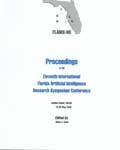Published:
May 1998
Proceedings:
Proceedings of the Eleventh International Florida Artificial Intelligence Research Society Conference (FLAIRS 1998)
Volume
Issue:
Proceedings of the Eleventh International Florida Artificial Intelligence Research Society Conference (FLAIRS 1998)
Track:
All Papers
Downloads:
Abstract:
Positron Emission Tomography (PET) combined with a neural network for discrimination has shown promise for distinguishing patients with Alzheimer’s disease (AD) from normal patients (Kippnehahn et al, 1992; Kippenhahn et al., 1994, Chan et al. 1994, Page et al. 1996). Usually only a few parameters from the PET image are used, typically regions of inter est (ROI) data based on regional cerebral metabolic rates for glucose (rCMRglc) in multiple lobes. Such representation is highly compressed. Averaging or compression may eliminate a good deal of useful information. Advantages of such compact representation include convenience of usage of standard parameters, intuitive anatomical interpretation and fast training of the neural network. An alternative approach is to use the image as the network input pattern.

FLAIRS
Proceedings of the Eleventh International Florida Artificial Intelligence Research Society Conference (FLAIRS 1998)
ISBN 978-1-57735-051-4
Published by The AAAI Press, Menlo Park, California
